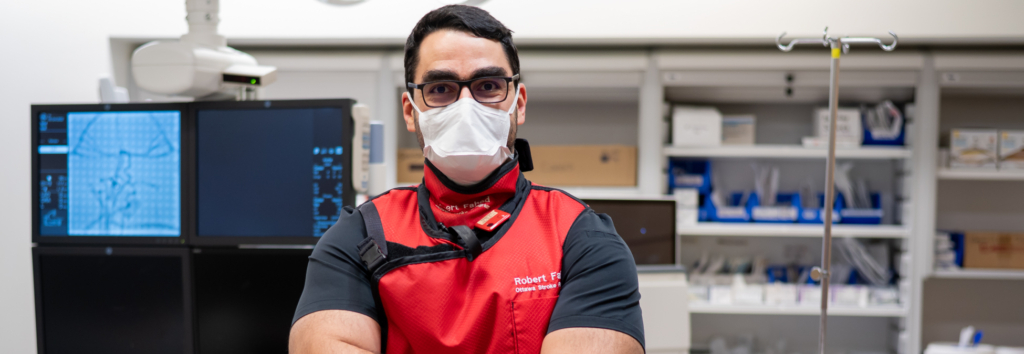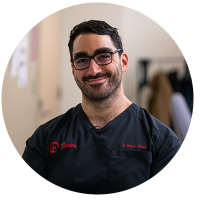Published: November 2022
When caring for patients who suffer from a stroke — time is of the essence. In Canada, stroke is the third leading cause of death and disability in adults, but an innovative and ever-evolving stroke treatment, called thrombectomy, used at The Ottawa Hospital, is a game changer. The Ottawa Hospital is recognized worldwide for expertise in neuroscience, and we’ve made significant strides in addressing today’s most pressing challenges in neuroscience — including our international, groundbreaking work in stroke. In fact, we are leading the way in how stroke care is delivered in Canada, including the use of thrombectomy.
Ten years ago, a thrombectomy was an experimental stroke treatment — with life-altering potential. Dr. Robert Fahed was a medical student doing his residency program in neurology at a prestigious hospital in Paris, France, when he was first introduced to this novel procedure. In fact, he vividly recalls the results from the first thrombectomy he witnessed. “A woman in her 50s suffered a massive stroke. Her right side was paralyzed, and she was unable to speak because of the stroke. Unfortunately, she wasn’t a candidate for a drug used to dissolve the clot in the brain,” explains Dr. Fahed. “I thought to myself, this poor woman will be paralyzed for the rest of her life, if she survives.”
That’s when a member of the care team explained they were going to try an experimental treatment called thrombectomy. Dr. Fahed continued with his rounds and 30 minutes later, he received a shocking call. “The patient was moving her right arm. She wasn’t paralyzed anymore. I immediately thought, ‘I don’t know what happened in that room, but I want to be the one doing these interventions. I want to be the one bringing those people back to life. That’s what I want to do.’”
Attracting the best and brightest from around the world
Today, Dr. Fahed is one of only four interventional neuroradiologists and stroke neurologists in Canada. He was recruited to The Ottawa Hospital in 2019 — fulfilling his childhood dream of coming to live in Canada.
His parents immigrated to France from Syria before he and his sister were born, hoping for a better life for their children. Growing up in the suburbs of Paris, Dr. Fahed watched his father, a neurologist, care for patients day in and day out. And so, the field of neurology was a natural path for him to follow. “I’ve always liked neurology. It was pretty clear to me that I wanted to become a doctor. I was seeing my father as my hero. One of my very first electives was in stroke neurology.”

“The Ottawa Hospital is famous for its expertise in stroke. We have a very strong stroke program, and are a high-volume centre where we perform these treatments 150 to 200 times a year.”
— Dr. Robert Fahed
— Dr. Robert Fahed
What are the symptoms of a stroke?
- Sudden weakness, numbness, or paralysis, especially on one side of the body
- Sudden confusion, difficulty speaking or understanding when others are speaking
- Sudden trouble seeing — including blurred or double vision — in one or both eyes
- Sudden trouble walking, dizziness, or loss of balance
- Sudden severe headache with no other explanation
Dr. Fahed did most of his training at the Rothschild Hospital in France, which he describes as one of the centres where interventional neurology was pioneered. But this young physician also had a deep desire to do research, so he completed a master’s degree in Montreal before returning to Paris — but always longed to come back to Canada. “The Ottawa Hospital is known for its great research infrastructure and how much it supports researchers.”
New technology changes the outcome for stroke patients
One-quarter of Canadians living with stroke are under age 65, and the risk of stroke rises rapidly after age 55. Eighty-seven percent of all strokes are ischemic strokes — when a vessel supplying blood to the brain is blocked by a clot.
The late Dr. Cheemun Lum and Dr. Dar Dowlatshahi helped pioneer a technique called endovascular thrombectomy (ET) that saved the lives of numerous stroke patients. The findings from the trial known as ESCAPE were released in 2015. This unique procedure is performed by inserting a thin tube in the groin, where it travels through an artery until it reaches the clot in the brain. With the help of X-ray technology, the clot is then sucked out with the help of a pump, restoring blood flow to the brain.
A major blood vessel in the brain is blocked by a blood clot, causing an acute ischemic stroke.
A thin catheter inserted into the groin travels through an artery until it reached the clot. A stent passes through the catheter and engages with the clot.
The stent is then pulled back taking the clot with it. The goal is to remove the entire clot on the first try to restore blood flow as quickly as possible, limiting damage caused by the stroke.
Blood flow is restored, and brain function can often improve immediately.
“We're aiming to remove the clot completely, on the first try. We call it a home run.”
– Dr. Robert Fahed
While this was a groundbreaking procedure, more work was needed to better perfect it as they could only re-open the blocked artery 50 to 60% of the time. “That clot is not always easy to remove. Sometimes you need to try multiple times. Sometimes you can only remove part of it. If you can only partially reopen the vessel, you only partially restore blood flow, which means that some regions of the brain will be damaged. So, we’re aiming to remove the clot completely, on the first try. We call it a home run,” says Dr. Fahed.
These home runs are becoming increasingly common thanks to new technology — and the results can be lifechanging. A patient can go from being paralyzed and unable to speak to talking and walking within 20 minutes of the procedure.
How can you check if someone is having a stroke?
If you suspect someone is having a stroke, experts recommend using the F.A.S.T. method.
- Face: Ask them to smile. Look for if one side droops.
- Arms: Ask them to raise their arms. Look for if one arm doesn’t lift as high or at all.
- Speech: Ask them to speak. Look for if their words are slurred or seem unusual.
- Time: If any of these signs appear, call 911 right away, and note when the first sign appeared.
How we helped refine the technology to provide better outcomes
Recently, a new catheter device developed by a start-up in Kitchener-Waterloo showed promise at removing the clot on the first try. The company reached out to our stroke team for help in testing the effectiveness of the Health Canada approved equipment. “The Ottawa Hospital is famous for its expertise in stroke. We have a very strong stroke program and are a high-volume centre where we perform these treatments 150 to 200 times a year,” says Dr. Fahed.
He adds, “We also have unparalleled scientific expertise in the design of studies to evaluate these tools. Because when you create a tool, you can’t just use it. You need to try it, evaluate it, and see if it’s safe and efficient. So, the company approached me and Dr. Brian Drake to investigate.”
They used 3D-printed silicone models to test this new stroke treatment option using fake clots in 3D-printed blood vessels that mimic a brain. They spent many hours trying different ways to use this catheter. “We wanted to determine the best and most effective way to use it in patients, and we found an approach that was very promising and extremely efficient in the silicone model. Then we designed a study that uses the catheter in stroke patients, and we will compare the results of this trial with trials using different tools and devices,” says Dr. Fahed.
"If the results continue this way, it's a major game changer. It's going to be a huge revolution in this field.”
– Dr. Robert Fahed
So far, the results are extremely promising. The success rate of pulling the clot out on the first try — the ‘home run’ — has increased significantly since using this newly devised catheter. “We are now able to pull the clot out completely on the first try in the vast majority of patients. If the results continue this way, it’s a major game changer. It’s going to be a huge revolution in this field.”

What’s the connection between COVID-19 and strokes?
COVID-19 has been found to cause neurological complications, not just respiratory issues. Early studies show that COVID-19 could more than double the risk of a stroke, especially in people with other risk factors. Multiple studies have shown even young people are at a higher risk of stroke because of COVID-19. People who experience a stroke with COVID-19 are also at a higher risk for death or disability.
Disruptive innovations and treatments thanks to research

“I'm proud to be part of such disruptive innovations and treatments — there is a lot of excitement in our field because the future is even brighter.”
– Dr. Robert Fahed
This treatment could be transformative for stroke patients and their families, and it if it continues to be successful, the benefits will be felt across the country impacting thousands — saving the lives of more people and saving them from disability. “I’m proud to be part of such disruptive innovations and treatments — there is a lot of excitement in our field,” smiles Dr. Fahed.
Research plays a vital role in where we are today and the innovative advancements we’ve seen to date. “Today’s research is tomorrow’s care. What we are studying today will be the cutting-edge, groundbreaking, disruptive treatment that we can offer to our patients tomorrow,” explains Dr. Fahed.
His constant search for new stroke treatment options continues in the research he does today. Dr. Fahed is currently assessing whether algorithms used to determine which people are eligible for thrombectomy may be missing some patients. He’s testing these algorithms to make sure they give the same answers when assessed by different physicians or machines. There’s also research into the type of drugs to give stroke patients when they’re with paramedics, prior to the arrival at the hospital.
– Mary Vanstone
According to Dr. Fahed, the future is bright, rapidly changing, and improving the lives of more patients. “The pace of evolution and improvement is exponentially higher and better every year. My job is already so different than what it was 10 years ago when I started. And 10 years from now, it will be a completely different field. We will be doing so many more things and doing them so much better.”
It’s a world that continues to fascinate this physician, much like that first thrombectomy he witnessed years ago.
“Today's research is tomorrow's care. What we are studying today will be the cutting-edge, groundbreaking, disruptive treatment that we can offer to our patients tomorrow.”
– Dr. Robert Fahed
Key stroke stats and facts
- Ischemic strokes happen when a blood vessel to the brain is obstructed by a blood clot
- 87% of all strokes are ischemic
- A transient ischemic attack, known as a “mini-stroke,” is caused by a temporary clot
- Hemorrhagic strokes happen when a weakened blood vessel ruptures
- Strokes are the leading cause of disability in adults in Canada
- Each year, approximately 50,000 people suffer strokes in Canada
- Two thirds of all strokes happen in people over 65
- Your risk of a stroke doubles every 10 years after turning 55
- Men have a slightly higher risk of stroke than women
- Risk factors for a stroke include: a family history, high blood pressure, high cholesterol, drug abuse, a high weight, inactivity, excessive alcohol consumption, smoking, sleep apnea, and diabetes
The Ottawa Hospital is a leading academic health, research, and learning hospital proudly affiliated with the University of Ottawa.





